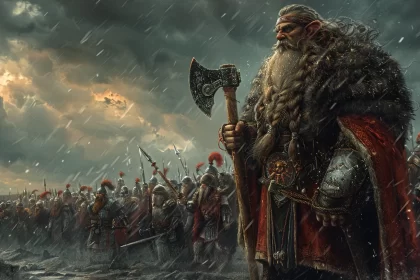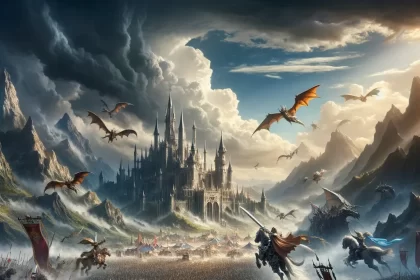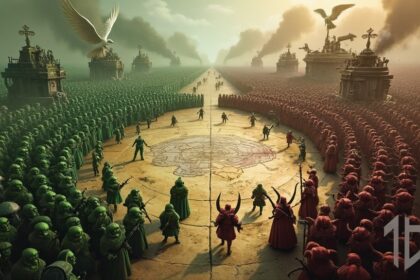The health of any tabletop game can often be gauged by its tournament activity, and Kings of War is no exception. Countercharge, in particular, has been active in arguing that a new 4th edition is necessary to reinvigorate the game and drive engagement. Is this truly the case? To better understand the state of Kings of War in the UK, I analyzed tournament data from kowmasters.com, which tracks a range of UK-based events. The results are illuminating: while participation numbers expectedly dipped during the pandemic, overall, the tournament scene is showing signs of growth and sustained interest.
Data Overview
The dataset provides details on tournament events, players, and their chosen factions across multiple years. By examining trends in total events, total player entries, and unique player participation each year, we can capture a snapshot of the game’s health and growth trajectory.
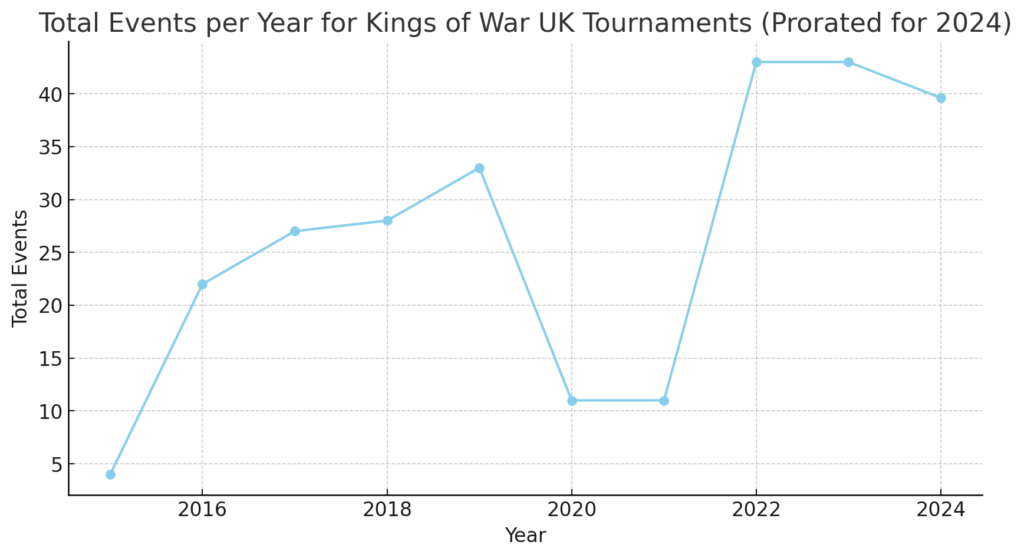
1. Total Events per Year
An essential metric in the analysis was the number of events hosted each year. Predictably, there was a dip in events in 2020, but 2021 saw a quick rebound as players returned to in-person play. Since then, the total number of events per year has been steadily increasing, indicating that organizers are ramping up opportunities for players to engage and compete.
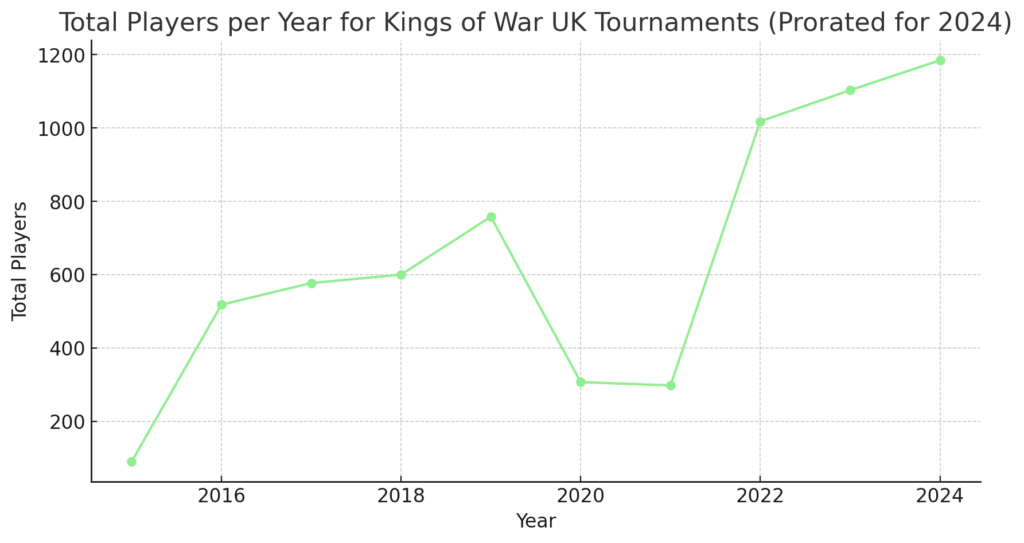
2. Total Players per Year
While event count gives an overview of organizational activity, total player entries measure the level of engagement from the community. In the years following the pandemic, total player entries have grown robustly. For example, the last couple of years, 2023 and 2024, show the highest participation levels since we began tracking, which speaks to the community’s enthusiasm and commitment. This increase suggests that not only are more tournaments being hosted, but attendance per tournament is also strong.
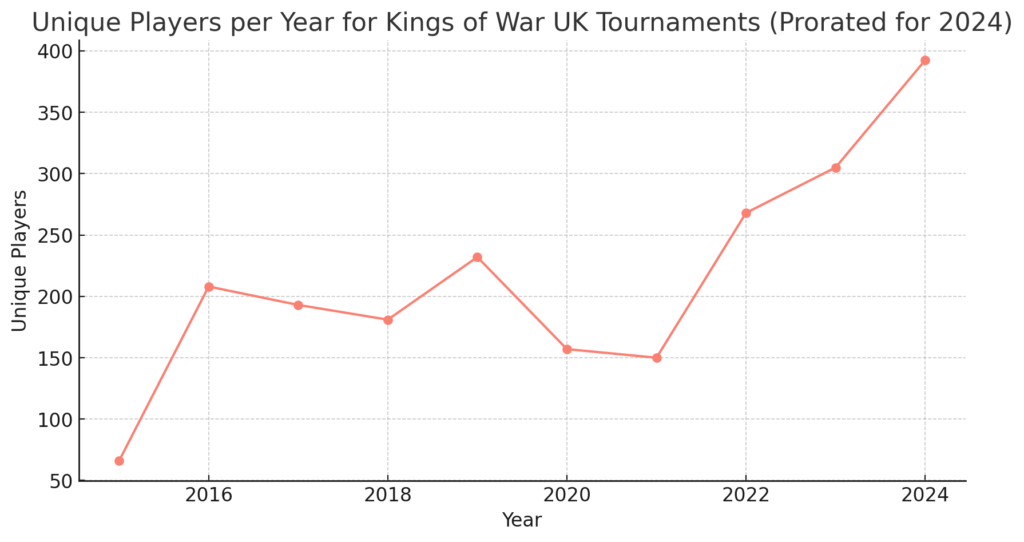
3. Unique Players per Year
Tracking unique players per year reveals insights into the community’s diversity and depth. An increase in unique players suggests that Kings of War is attracting newcomers and not just relying on a core group of repeat players. The data shows steady growth in unique players since 2020, hinting at successful community engagement efforts and perhaps indicating that the game is resonating with a broader audience. In fact, the number of unique players in 2024 (prorated for the full year) is higher than in any previous year, demonstrating sustained interest.
Is the Scene Really Growing?
Given this evidence, it seems that the UK Kings of War scene is not only recovering from the pandemic but thriving. When discussions arise—such as on popular podcasts like Countercharge—about whether Kings of War is growing or stagnating, this data from UK tournaments suggests that the game is healthy and expanding, at least in this region. While Countercharge raises thought-provoking questions about the game’s growth worldwide, the UK tournament scene is a positive example of how organized play can drive community growth and engagement.
Community Diversity: A Look at HHI
To add depth to this analysis, I went back to one of my favorite metrics and calculated the Herfindahl-Hirschman Index (HHI) for each year, which measures how participation is spread across players. A lower HHI score means that more players are contributing to the scene, rather than a small group dominating. In other words, HHI is useful to determine whether new people are joining the tournament scene, or whether we’re just seeing the same core group of people over and over again.
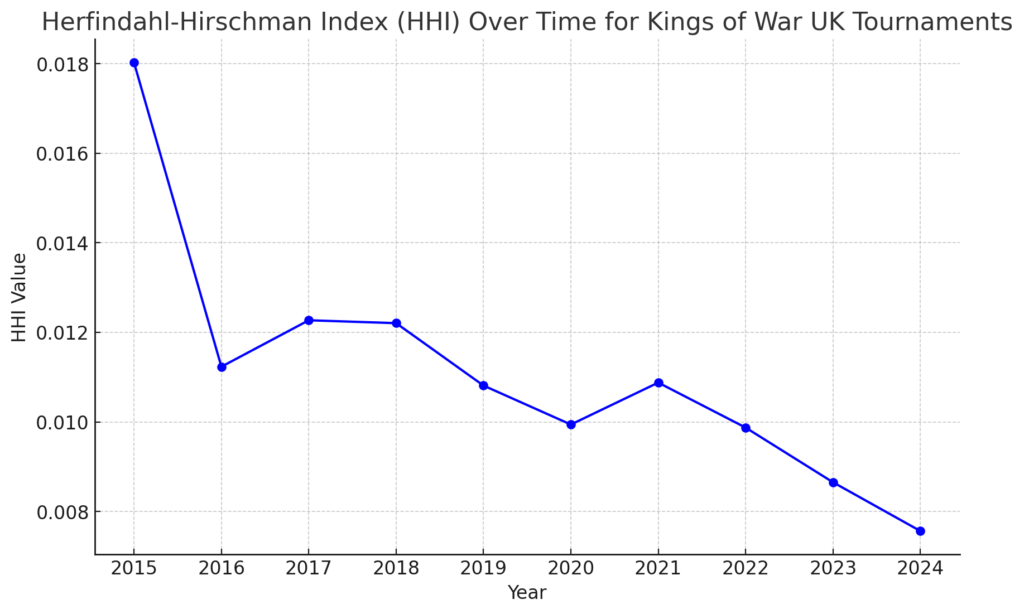
Over the years, the HHI for UK Kings of War tournaments has decreased, meaning that participation is becoming more diverse, and no single player or group of players is monopolizing events. This growing diversity is a great indicator that Kings of War is reaching a wider audience, ensuring long-term health and stability.
Player Retention and Growth
Finally, I wanted to take a look at player retention and turnover. By examining new players, returning players, and dropped players for each year, we can see how the community evolves over time. The data reveals interesting dynamics in the player base:
- New Players: Each year, we see a healthy influx of new players. This metric helps demonstrate the attractiveness of the game and the ability of the community to draw in fresh participants.
- Returning Players: The number of players who return each year indicates the game’s stickiness and how enjoyable players find the competitive scene.
- Dropped Players: By tracking players who participate one year but not the next, we can identify potential areas of concern where engagement may need reinforcement.
The table below highlights these trends over the years, showing a constant effort to bring in new players while retaining as many as possible:
| Year | New Players | Returning Players | Dropped Players |
|---|---|---|---|
| 2015 | 66 | 0 | 11 |
| 2016 | 153 | 55 | 98 |
| 2017 | 83 | 110 | 76 |
| 2018 | 65 | 117 | 58 |
| 2019 | 109 | 124 | 131 |
| 2020 | 45 | 95 | 138 |
| 2021 | 72 | 100 | 48 |
| 2022 | 93 | 125 | 89 |
| 2023 | 120 | 130 | 75 |
| 2024 | 134 | 142 | 102 |
As you can see, these numbers also look good. Since 2020, every year has seen more new players and more returning players. While there are drops from year to year, it suggests to me that we’re seeing healthy growth in the game. A steady flow of new players alongside a significant number of returning participants suggests that the UK Kings of War tournament scene remains both attractive and rewarding for its players.
Final Thoughts
The UK Kings of War scene looks healthy and resilient, showing promising growth in both the number of events and player diversity. Although external factors like the pandemic temporarily dampened participation, the community bounced back strongly, with 2024 on track to be one of the best years yet. This data-based perspective suggests that, while there may always be challenges, the Kings of War tournament community in the UK is well on its way to a bright future.
While I appreciate Countercharge’s concern about the health of the game, looking at the data available in the UK scene strongly suggests to me that the game is in a strong, healthy place. For fans and organizers alike, these trends highlight the importance of organized play and community engagement in sustaining and growing the scene. As we continue tracking these metrics, let’s hope they inspire similar growth in Kings of War communities worldwide.



